 |
Chess is a two-player board game played on a chessboard, a square-checkered board with 64 squares arranged in an eight-by-eight grid. It is one of the world's most popular games, played by millions of people worldwide at home, in clubs, online, by correspondence, and in tournaments. . |
History Of Chess
The origins of chess is one of the most controversial areas of board gaming history. Countries which, at one time or the other, have been associated with invention of chess include China, India, Egypt, Greece, Assyria, Persia, Arabia, Ireland and Uzbekistan. By far, the most commonly held belief is that chess originated in India. The earliest mention of chess appears in the Indian classic, the Mahabharata, written circa 2,000 BC, where it was called Chaturanga. As a matter of fact, the Arabic, Persian, Greek and Spanish words for chess, are all derived from the Sanskrit Chaturanga. The present version of chess played throughout the world is ultimately based on a version of Chaturanga that was played in India around the 6th century AD. It is also believed that the Persians may have created a more modern version of the game after the Indians. In fact, the oldest known chess pieces have been found in excavations of ancient Persian territories. Another theory exists that chess arose from the similar game of Chinese chess, or at least a predecessor, thereof, existing in China since the 2nd century B.C. Joseph Needham and David H. Li are two of many scholars who have favored this theory. Top
Rules And Regulations of playing chess: How To Play Chess?
Chess is a game, played by two players. One player plays with the white pieces, and the other player plays with the black pieces. Each player has sixteen pieces in the beginning of the game: one king, one queen, two rooks, two bishops, two knights, and eight pawns. The game is played on a chessboard, consisting of 64 squares: eight rows and eight columns. The squares are alternately light (white) and dark colored. The board must be laid down such that there is a black square in the lower-left corner. To facilitate notation of moves, all squares are given a name. From the view of the white player, the rows are numbered 1, 2, 3, 4, 5, 6, 7, 8; the lowest row has number 1, and the upper row has number 8. The columns are named, from left to right, a, b, c, d, e, f, g, h. A square gets a name, consisting of the combination of its column-letter and row-number, e.g., the square in the lower left corner (for white) is a1.
Black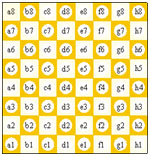
White
Alternately, the players make a move, starting with the white player (the player that plays with the white pieces.) A move consists of moving one of the pieces of the player to a different square, following the rules of movement for that piece - there is one special exception, namedcastling, where players move two pieces simultaneously.
A player can take a piece of the opponent by moving one of his own pieces to the square that contains a piece of the opponent. The opponents piece then is removed from the board, and out of play for the rest of the game. (Taking is not compulsory.)
At the start of the game, the position of the pieces is as follows.
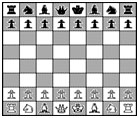
Thus, at the second row, there are eight white pawns, at the seventh row, there are eight black pawns. At the first row, from left to right, we have a: rook, knight, bishop, queen, king, bishop, knight, and rook. Note that the queens start of squares of their own color, with a dark square in each players left hand corner.
Movement of the pieces:
Rook:The rook moves in a straight line, horizontally or vertically. The rook may not jump over other pieces, that is: all squares between the square where the rook starts its move and where the rook ends its move must be empty. (As for all pieces, when the square where the rook ends his move contains a piece of the opponent, then this piece is taken. The square where the rook ends his move may not contain a piece of the player owning this rook.)
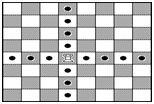
Bishop:
The bishop moves in a straight diagonal line. The bishop may also not jump over other pieces.
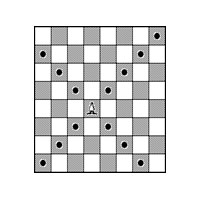
Queen:
The queen has the combined moves of the rook and the bishop, i.e., the queen may move in any straight line, horizontal, vertical, or diagonal.
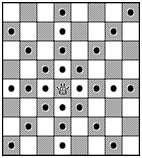
Knight
The knight makes a move that consists of first one step in a horizontal or vertical direction, and then one step diagonally in an outward direction. The knight jumps: it is allowed that the first square that the knight passes over is occupied by an arbitrary piece. For instance, white can start the game by moving his knight from b1 to c3. The piece that is jumped over is further not affected by the knight: as usual, a knight takes a piece of the opponent by moving to the square that contains that piece.
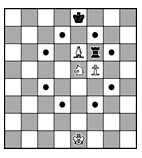
Pawn
The pawn moves differently regarding whether it moves to an empty square or whether it takes a piece of the opponent. When a pawn does not take, it moves one square straight forward. When this pawn has not moved at all, i.e., the pawn is still at the second row (from the owning players view), the pawn may make a double step straight forward. For instance, a white pawn on d2 can be moved to d4.
When taking, the pawn goes one square diagonally forward.
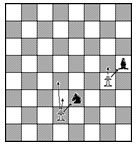
There is one special rule, called taking en-passant. When a pawn makes a double step from the second row to the fourth row, and there is an enemy pawn on an adjacent square on the fourth row, then this enemy pawn inthe next move may move diagonally to the square that was passed over by the double-stepping pawn, which is on the third row. In this same move, the double-stepping pawn is taken. This taking en-passant must be done directly: if the player who could take en-passant does not do this in the first move after the double step, this pawn cannot be taken anymore by an en-passant move.
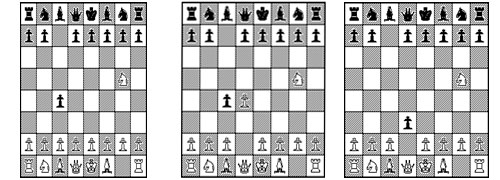
A double pawn step, and a following en-passant capture
Pawns that reach the last row of the board promote. When a player moves a pawn to the last row of the board, he replaces the pawn by a queen, rook, knight, or bishop (of the same color). Usually, players will promote the pawn to a queen, but the other types of pieces are also allowed. (It is not required that the pawn is promoted to a piece taken. Thus, it is for instance possible that a player has at a certain moment two queens.)
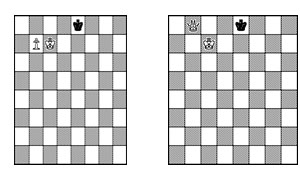
Before and after a promotion
King: The king moves one square in any direction, horizontally, vertically, or diagonally. There is one special type of move, made by a king and rook simultaneously, called castling: see below. The king is the most important piece of the game, and moves must be made in such a way that the king is never in check: see below.
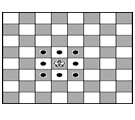
Castling
Under certain, special rules, a king and rook can move simultaneously in a castling move.
The following conditions must be met:
• The king that makes the castling move has not yet moved in the game.
• The rook that makes the castling move has not yet moved in the game.
• The king is not in check.
• The king does not move over a square that is attacked by an enemy piece during the castling move, i.e., when castling, there may not be an enemy piece that can move (in case of pawns: by diagonal movement) to a square that is moved over by the king.
• The king does not move to a square that is attacked by an enemy piece during the castling move, i.e., you may not castle and end the move with the king in check.
• All squares between the rook and king before the castling move are empty.
• The King and rook must occupy the same rank (or row).
When castling, the king moves two squares towards the rook, and the rook moves over the king to the next square, i.e., black's king on e8 and rook on a8 move to: king c8, rook d8 (long castling), white's king on e1 and rook on h1 move to: king g1, rook f1 (short castling).
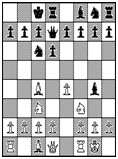
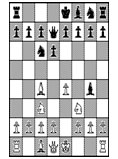
position before and after castling: white short, and black long
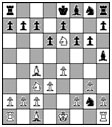
Neither white nor black may castle: white is in check, and the black king may not move over d8>
Check, mate, and stalemate
Check
When the king of a player can be taken by a piece of the opponent, one says that the king is in check. For instance, the white player moves his rook to a position such that it attacks the black king, i.e., if black doesn't do anything about it, the rook could take the black king in the next move: we say that the white rook gives check. It is considered good manners to say check when one checks ones opponent.
It is not allowed to make a move, such that ones king is in check after the move. If a player accidently tries to make such a move, he must take the move back and make another move (following the rules that one must move with the piece one has touched, see below.)
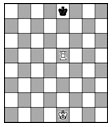
Mate
When a player is in check, and he cannot make a move such that after the move, the king is not in check, then he ismated. The player that is mated lost the game, and the player that mated him won the game.
Note that there are three different possible ways to remove a check:
1. Move the king away to a square where he is not in check.
2. Take the piece that gives the check.
3. (In case of a check, given by a rook, bishop or queen: ) move a piece between the checking piece and the king.
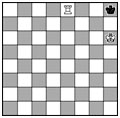
Stalemate
When a player cannot make any legal move, but he is not in check, then the player is said to be stalemated. In a case of a stalemate, the game is a draw.
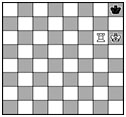
When black must move, the game is a stalemate
Other rules
There are other rules, telling what should happen in special occasions, like that players started the game with a wrong setup, etc. These are not so important for friendly games. Top
Countries Ranking
Country rank by average rating of top 10 playersTop
Chess Players
Highest Rated Chess Palyers Of ALL time
José Raúl Capablanca (1888-1942) from Cuba
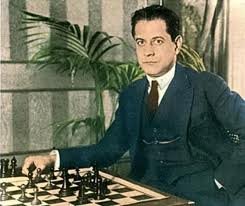
World Champion for 6 years 1921-1927
José Raúl Capablanca, the second surviving son of a Spanish army officer, was born in Havana, Cuba on November 19, 1888. According to Capablanca, he learned the rules of the game at the age of four by watching his father play, pointed out an illegal move by his father, and then beat his father twice. At the age of 13 he beat the Cuban national champion. Capablanca played in numerous simultaneous exhibitions, sometimes playing hundreds of opponents at a time and usually winning 95 percent or more of the games. In one exhibition in the U.S., he played 103 simultaneous games over six hours, winning 102, drawing one, losing ZERO (99.5%). Even when he played against other Grandmasters of chess, he usually won by wide margins.
Emanuel Lasker (1868-1941) from Germany
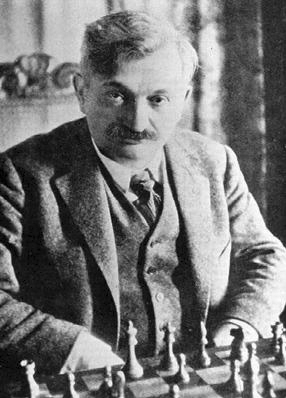
Undisputed World Champion for 27 years 1894-1921 Dr. Emanuel Lasker is the longest reigning World Champion in modern times and when there were clear championship matches performed. He was born on December 24, 1868 at Berlinchen in Neumark (now Barlinek in Poland), the son of a Jewish cantor. At the age of eleven he was sent to Berlin to study mathematics, where he lived with his brother Berthold, eight years his senior, who taught him how to play chess. He earned a doctorate (Ph.D.) in mathematics in 1902. After winning the world championship, he successfully defended his title 5 times, two of the times winning the match without a single loss. However, there were two 9 years periods during his reign where he did not have to defend his title, out of the total 27 years as champion.
Garry Kasparov
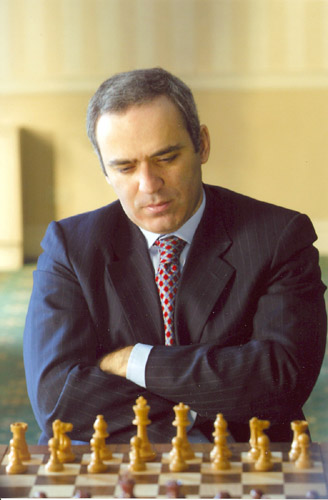
Style: Brilliant Tactician and Attacker. An aggressively dynamic player. Noted chess teacher Bruce Pandolfini described Kasparov in this fashion, "Kasparov strives to gain deep positional sacrifices: Even when he can't calculate the end result conclusively, he can make sophisticated generalizations. He does anything to get the initiative and to force the play. Inevitably, he emerges from a forest of complications -- in which his intentions aren't all that clear -- with the advantage. He's not as artful or as clear as Fischer, but his play coincides with the realities of the day, which are all about defense."
• In 1980, he won the World Junior Championship.
• From December 1981 to February 1991, Kasparov made chess history by not losing a single event for nearly ten years. This was the period in which he created his reputation of invincibility.
• Reigned as world champion in the modern chess age for 15 years from 1985 to 2000.
• Was the youngest chess champion in history at age 22.
• Number one rated player since 1985 to present day, which is 18 years at the top.
• Kasparov and Karpov began their marathon match in Moscow. The match was for the first to win 6 games. After 3 wins, 40 draws, and 5 losses, FIDE President Campomanes stopped the match after 5 months of play. The match was halted after Kasparov had just won 2 games in a row.
• On September 3, 1985 Kasparov and Karpov resumed their match in Moscow. This time, Kasparov won with 5 wins, 3 losses and 16 draws. The match had been limited to 24 games.
• 1986 Kasparov defended his title against Karpov in London, then in Leningrad. Kasparov won with 5 wins, 4 losses and 15 draws.
• 1st place Brussels (OHRA) 1986.
• 1st place shared with Ljuobjevic at Brussels (SWIFT) 1987.
• Kasparov defended his title in Seville, Spain 1987 against Karpov. He retained his title by drawing the match with 4 wins, 4 losses, and 16 draws.
• Won 1990 World Championship match with Karpov won 4 lost 3 with 17 draws.
• 1st place at Linares Super GM Tournament. This was a Category 18 event, with 11 of the top 14 players in the world participating
• Won PCA World Championship match in London against Nigel Short. Kasparov won the match with a score of 12.5 - 7.5.
• Won Intel-PCA World Chess Championship over Vishy Anand in 1995 4-1-13.
• Won total of 8 Linares Super GM tournaments outright, including his 2000 victory 3 points ahead of all players.
• Won 10 Super GM Tournaments in a row
Bobby Fischer (1943-2008) from the U.S.
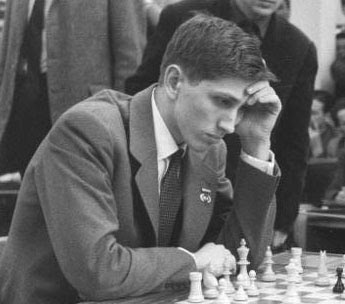
Fischer at a tournament in 1960 at the age of only 17
World Champion 1972-1975 Bobby Fischer was born to a Jewish woman of Polish descent and a German biophysicist. He was a chess prodigy, learning the game at age 6 and excelling at it at a very young age. In 1956 at the age of only 13 he played what many have called "The Game of the Century" defeating the U.S. champion. In 1971 in a semi-final match to play for the World Championship, he beat Bent Larsen, a grandmaster and genuine candidate for the World title 6/6 (six straight wins). Fischer was a great boon to chess in the U.S., igniting a huge increase in chess participation and interest in the U.S. and also in other parts of the world. In a previous edition of the Guiness Book of Records, his I.Q. was listed at 163 which is well into the genius range. However, he had poor social skills, did not get along with others well or the press and was often seen as rude and arrogant. For this, he may have done as much harm to chess than the good he did. In spite of being at least half Jewish (there are some reports that his biological father was also Jewish, making him full-Jewish by birth), he was fiercely anti-Semitic. Top
Viswanathan Anand (1969- ) from India (Tamil Nadu)
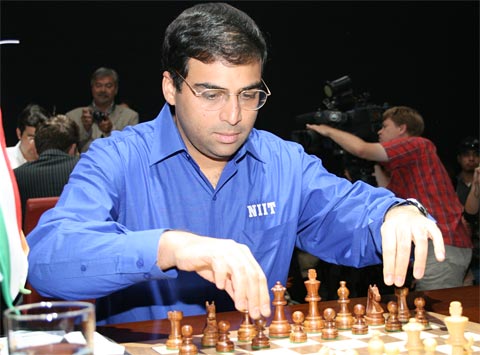
* World Champion 2000-2002 (FIDE)
* Undisputed World Champion 2007 and continuing through today (most recent defense of title in 2010)
Viswanathan Anand represents a great achievement for chess, being Indian born, where the game of chess originated. It started around the first to fifth century CE in India as Chaturanga and then later most popular in the Middle East as Shatranj and then to the current form of chess as we know it. Viswanathan Anand may be a catalyst to the game for India and the rest of Asia the way Bobby Fischer elevated the popularity of chess in the U.S. starting in 1972 when he won the World Championship.
Viswanathan Anand is not at this rank position simply because he is Indian or Hindu, but because he truly is a very strong player, with one of the highest recorded ratings. As the current World Champion and an active player, he could go up on my list here of the all-time best, at some future date.